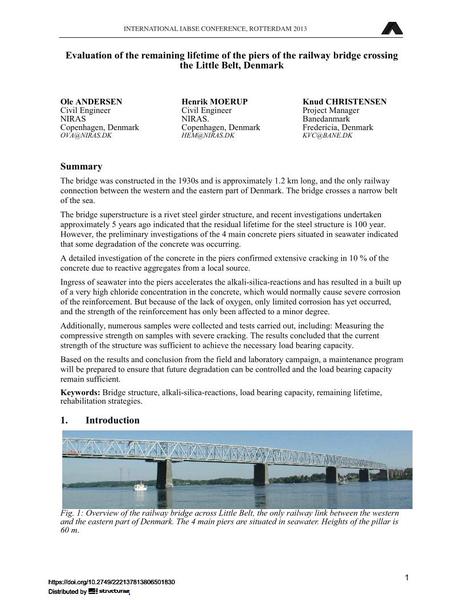Evaluation of the remaining lifetime of the piers of the railway bridge crossing the Little Belt, Denmark

|
|
|||||||||||
Bibliografische Angaben
| Autor(en): |
Ole Andersen
Henrik Moerup Knud Christensen |
||||
|---|---|---|---|---|---|
| Medium: | Tagungsbeitrag | ||||
| Sprache(n): | Englisch | ||||
| Tagung: | IABSE Conference: Assessment, Upgrading and Refurbishment of Infrastructures, Rotterdam, The Netherlands, 6-8 May 2013 | ||||
| Veröffentlicht in: | IABSE Conference, Rotterdam, May 2013 | ||||
|
|||||
| Seite(n): | 408-409 | ||||
| Anzahl der Seiten (im PDF): | 8 | ||||
| Jahr: | 2013 | ||||
| DOI: | 10.2749/222137813806501830 | ||||
| Abstrakt: |
The bridge was constructed in the 1930s and is approximately 1.2 km long, and the only railway connection between the western and the eastern part of Denmark. The bridge crosses a narrow belt of the sea. The bridge superstructure is a rivet steel girder structure, and recent investigations undertaken approximately 5 years ago indicated that the residual lifetime for the steel structure is 100 year. However, the preliminary investigations of the 4 main concrete piers situated in seawater indicated that some degradation of the concrete was occurring. A detailed investigation of the concrete in the piers confirmed extensive cracking in 10 % of the concrete due to reactive aggregates from a local source. Ingress of seawater into the piers accelerates the alkali-silica-reactions and has resulted in a built up of a very high chloride concentration in the concrete, which would normally cause severe corrosion of the reinforcement. But because of the lack of oxygen, only limited corrosion has yet occurred, and the strength of the reinforcement has only been affected to a minor degree. Additionally, numerous samples were collected and tests carried out, including: Measuring the compressive strength on samples with severe cracking. The results concluded that the current strength of the structure was sufficient to achieve the necessary load bearing capacity. Based on the results and conclusion from the field and laboratory campaign, a maintenance program will be prepared to ensure that future degradation can be controlled and the load bearing capacity remain sufficient. |
||||
| Stichwörter: |
Alkali-Kieselsäure-Reaktion
|
||||
